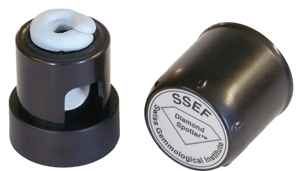GIA recently announced its entry into the race for a reliable method to detect synthetic diamonds with the DiamondCheck, a device priced at $24,000. This is considerably less than rumoured $25,000 per year lease for the De Beers Automated Melee Screening device (AMS) to be on the market later this year and only available to sightholders. DTC has the Diamond Sure at around $10,000 and the DiamondView for close to $50,000.
Other devices on the market include the HRD D-Screen for $3600 and the SSEF Diamond Spotter for $150. These two use Short Wave UltraViolet transparency to detect Type IIa diamonds. As of now virtually all synthetic diamonds are Type IIa although there are reports of new synthetic diamonds in the Type IaAB category. A new device using a laser, scheduled to debut in March, is reported to be able to detect Type IaAB as well.

SSEF Diamond Spotter
All of these devices have one thing in common; they can only tell you if a diamond is natural or needs additional testing. Nothing more. As of now there is no single device that can tell you conclusively that a diamond is synthetic.
Reliable, affordable identification of synthetic diamonds is the Holy Grail of gemmological research. And like the Holy Grail of legend, this may never be found. If such a device can be developed it will always lag behind the technology for growing diamonds, rendering it obsolete before it hits the streets. Even then, it may already be too late. There are thousands of undisclosed synthetic diamonds in the market with more entering every day.
The development of these devices is important and necessary. But the problem extends far beyond the science of detection; it is now a matter of marketing and education. The diamond industry currently is wringing its collective hands and lamenting how this will hurt or possibly even destroy the diamond market. Increasingly stringent rules for top-level dealers within the diamond bourses and trade associations can only act as a band-aide and not a cure…because there will never be a cure. Synthetic diamonds are here to stay and most of them will hit the market without disclosure no matter what the big players do to prevent it. They will enter much farther down the supply chain where both education and ethics are rare.
The diamond industry must pull its head out of the sand and accept that the problem of synthetics will not go away and cannot be stopped. It needs to figure out a way to re-brand and reposition the public perception of diamonds to include undetected and undisclosed synthetics in harmony with natural stones for the use of common, commercial jewellery. Perhaps one possibility is marketing the importance of the physical characteristics of all diamonds to keep the desire for the material while promoting the rarity of fine natural gems for those that can afford them. They need to get going on this soon or it will be too late.
